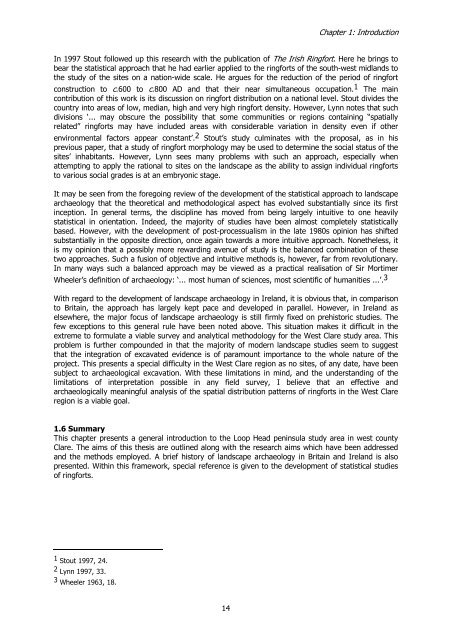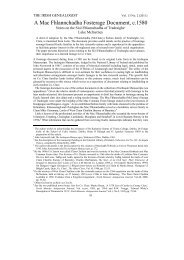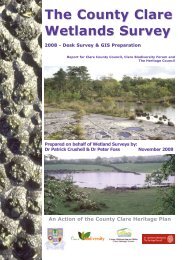A Statistical Analysis of Ringfort Distribution and Morphology on the ...
A Statistical Analysis of Ringfort Distribution and Morphology on the ...
A Statistical Analysis of Ringfort Distribution and Morphology on the ...
Create successful ePaper yourself
Turn your PDF publications into a flip-book with our unique Google optimized e-Paper software.
Chapter 1: Introducti<strong>on</strong><br />
In 1997 Stout followed up this research with <strong>the</strong> publicati<strong>on</strong> <str<strong>on</strong>g>of</str<strong>on</strong>g> The Irish <str<strong>on</strong>g>Ringfort</str<strong>on</strong>g>. Here he brings to<br />
bear <strong>the</strong> statistical approach that he had earlier applied to <strong>the</strong> ringforts <str<strong>on</strong>g>of</str<strong>on</strong>g> <strong>the</strong> south-west midl<str<strong>on</strong>g>and</str<strong>on</strong>g>s to<br />
<strong>the</strong> study <str<strong>on</strong>g>of</str<strong>on</strong>g> <strong>the</strong> sites <strong>on</strong> a nati<strong>on</strong>-wide scale. He argues for <strong>the</strong> reducti<strong>on</strong> <str<strong>on</strong>g>of</str<strong>on</strong>g> <strong>the</strong> period <str<strong>on</strong>g>of</str<strong>on</strong>g> ringfort<br />
c<strong>on</strong>structi<strong>on</strong> to c.600 to c.800 AD <str<strong>on</strong>g>and</str<strong>on</strong>g> that <strong>the</strong>ir near simultaneous occupati<strong>on</strong>. 1 The main<br />
c<strong>on</strong>tributi<strong>on</strong> <str<strong>on</strong>g>of</str<strong>on</strong>g> this work is its discussi<strong>on</strong> <strong>on</strong> ringfort distributi<strong>on</strong> <strong>on</strong> a nati<strong>on</strong>al level. Stout divides <strong>the</strong><br />
country into areas <str<strong>on</strong>g>of</str<strong>on</strong>g> low, median, high <str<strong>on</strong>g>and</str<strong>on</strong>g> very high ringfort density. However, Lynn notes that such<br />
divisi<strong>on</strong>s ‘... may obscure <strong>the</strong> possibility that some communities or regi<strong>on</strong>s c<strong>on</strong>taining “spatially<br />
related” ringforts may have included areas with c<strong>on</strong>siderable variati<strong>on</strong> in density even if o<strong>the</strong>r<br />
envir<strong>on</strong>mental factors appear c<strong>on</strong>stant’. 2 Stout’s study culminates with <strong>the</strong> proposal, as in his<br />
previous paper, that a study <str<strong>on</strong>g>of</str<strong>on</strong>g> ringfort morphology may be used to determine <strong>the</strong> social status <str<strong>on</strong>g>of</str<strong>on</strong>g> <strong>the</strong><br />
sites’ inhabitants. However, Lynn sees many problems with such an approach, especially when<br />
attempting to apply <strong>the</strong> rati<strong>on</strong>al to sites <strong>on</strong> <strong>the</strong> l<str<strong>on</strong>g>and</str<strong>on</strong>g>scape as <strong>the</strong> ability to assign individual ringforts<br />
to various social grades is at an embry<strong>on</strong>ic stage.<br />
It may be seen from <strong>the</strong> foregoing review <str<strong>on</strong>g>of</str<strong>on</strong>g> <strong>the</strong> development <str<strong>on</strong>g>of</str<strong>on</strong>g> <strong>the</strong> statistical approach to l<str<strong>on</strong>g>and</str<strong>on</strong>g>scape<br />
archaeology that <strong>the</strong> <strong>the</strong>oretical <str<strong>on</strong>g>and</str<strong>on</strong>g> methodological aspect has evolved substantially since its first<br />
incepti<strong>on</strong>. In general terms, <strong>the</strong> discipline has moved from being largely intuitive to <strong>on</strong>e heavily<br />
statistical in orientati<strong>on</strong>. Indeed, <strong>the</strong> majority <str<strong>on</strong>g>of</str<strong>on</strong>g> studies have been almost completely statistically<br />
based. However, with <strong>the</strong> development <str<strong>on</strong>g>of</str<strong>on</strong>g> post-processualism in <strong>the</strong> late 1980s opini<strong>on</strong> has shifted<br />
substantially in <strong>the</strong> opposite directi<strong>on</strong>, <strong>on</strong>ce again towards a more intuitive approach. N<strong>on</strong>e<strong>the</strong>less, it<br />
is my opini<strong>on</strong> that a possibly more rewarding avenue <str<strong>on</strong>g>of</str<strong>on</strong>g> study is <strong>the</strong> balanced combinati<strong>on</strong> <str<strong>on</strong>g>of</str<strong>on</strong>g> <strong>the</strong>se<br />
two approaches. Such a fusi<strong>on</strong> <str<strong>on</strong>g>of</str<strong>on</strong>g> objective <str<strong>on</strong>g>and</str<strong>on</strong>g> intuitive methods is, however, far from revoluti<strong>on</strong>ary.<br />
In many ways such a balanced approach may be viewed as a practical realisati<strong>on</strong> <str<strong>on</strong>g>of</str<strong>on</strong>g> Sir Mortimer<br />
Wheeler’s definiti<strong>on</strong> <str<strong>on</strong>g>of</str<strong>on</strong>g> archaeology: ‘... most human <str<strong>on</strong>g>of</str<strong>on</strong>g> sciences, most scientific <str<strong>on</strong>g>of</str<strong>on</strong>g> humanities ...’. 3<br />
With regard to <strong>the</strong> development <str<strong>on</strong>g>of</str<strong>on</strong>g> l<str<strong>on</strong>g>and</str<strong>on</strong>g>scape archaeology in Irel<str<strong>on</strong>g>and</str<strong>on</strong>g>, it is obvious that, in comparis<strong>on</strong><br />
to Britain, <strong>the</strong> approach has largely kept pace <str<strong>on</strong>g>and</str<strong>on</strong>g> developed in parallel. However, in Irel<str<strong>on</strong>g>and</str<strong>on</strong>g> as<br />
elsewhere, <strong>the</strong> major focus <str<strong>on</strong>g>of</str<strong>on</strong>g> l<str<strong>on</strong>g>and</str<strong>on</strong>g>scape archaeology is still firmly fixed <strong>on</strong> prehistoric studies. The<br />
few excepti<strong>on</strong>s to this general rule have been noted above. This situati<strong>on</strong> makes it difficult in <strong>the</strong><br />
extreme to formulate a viable survey <str<strong>on</strong>g>and</str<strong>on</strong>g> analytical methodology for <strong>the</strong> West Clare study area. This<br />
problem is fur<strong>the</strong>r compounded in that <strong>the</strong> majority <str<strong>on</strong>g>of</str<strong>on</strong>g> modern l<str<strong>on</strong>g>and</str<strong>on</strong>g>scape studies seem to suggest<br />
that <strong>the</strong> integrati<strong>on</strong> <str<strong>on</strong>g>of</str<strong>on</strong>g> excavated evidence is <str<strong>on</strong>g>of</str<strong>on</strong>g> paramount importance to <strong>the</strong> whole nature <str<strong>on</strong>g>of</str<strong>on</strong>g> <strong>the</strong><br />
project. This presents a special difficulty in <strong>the</strong> West Clare regi<strong>on</strong> as no sites, <str<strong>on</strong>g>of</str<strong>on</strong>g> any date, have been<br />
subject to archaeological excavati<strong>on</strong>. With <strong>the</strong>se limitati<strong>on</strong>s in mind, <str<strong>on</strong>g>and</str<strong>on</strong>g> <strong>the</strong> underst<str<strong>on</strong>g>and</str<strong>on</strong>g>ing <str<strong>on</strong>g>of</str<strong>on</strong>g> <strong>the</strong><br />
limitati<strong>on</strong>s <str<strong>on</strong>g>of</str<strong>on</strong>g> interpretati<strong>on</strong> possible in any field survey, I believe that an effective <str<strong>on</strong>g>and</str<strong>on</strong>g><br />
archaeologically meaningful analysis <str<strong>on</strong>g>of</str<strong>on</strong>g> <strong>the</strong> spatial distributi<strong>on</strong> patterns <str<strong>on</strong>g>of</str<strong>on</strong>g> ringforts in <strong>the</strong> West Clare<br />
regi<strong>on</strong> is a viable goal.<br />
1.6 Summary<br />
This chapter presents a general introducti<strong>on</strong> to <strong>the</strong> Loop Head peninsula study area in west county<br />
Clare. The aims <str<strong>on</strong>g>of</str<strong>on</strong>g> this <strong>the</strong>sis are outlined al<strong>on</strong>g with <strong>the</strong> research aims which have been addressed<br />
<str<strong>on</strong>g>and</str<strong>on</strong>g> <strong>the</strong> methods employed. A brief history <str<strong>on</strong>g>of</str<strong>on</strong>g> l<str<strong>on</strong>g>and</str<strong>on</strong>g>scape archaeology in Britain <str<strong>on</strong>g>and</str<strong>on</strong>g> Irel<str<strong>on</strong>g>and</str<strong>on</strong>g> is also<br />
presented. Within this framework, special reference is given to <strong>the</strong> development <str<strong>on</strong>g>of</str<strong>on</strong>g> statistical studies<br />
<str<strong>on</strong>g>of</str<strong>on</strong>g> ringforts.<br />
1 Stout 1997, 24.<br />
2 Lynn 1997, 33.<br />
3 Wheeler 1963, 18.<br />
14
















